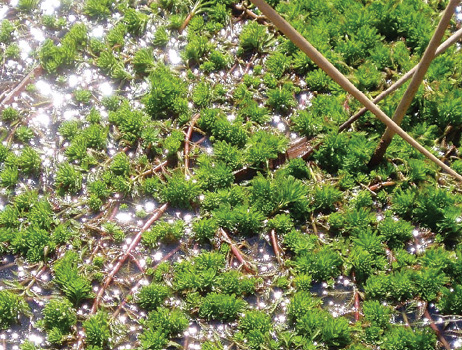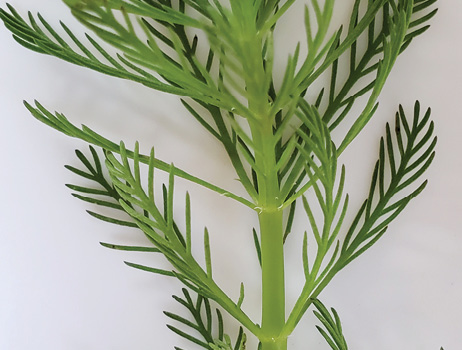Parrot’s-feather | Myriophyllum aquaticum
Emergent | Non-Native



Parrot’s-feather is a non-native species from South America that can be invasive and has been widely spread around the southern and western United States.
Leaves are a pale green to blue green and grow in whorls of four to six. Each leaf is about 1–2 inches long and divided into 10 or more thread-like filaments. This gives the leaves a feather-like appearance.
Although the species produces flowers, which are non-showy, white or pinkish branches that look like leaves, there are only female plants in the United States. Without a male to fertilize flowers, this species is infertile and does not produce viable seeds. Spread occurs via plant fragments.
Parrot’s-feather normally occurs in low densities but, under certain conditions, can become a significant problem. It can clog waterways, interfere with recreational water use, and displace native plants.
Management Value
Parrot’s-feather is an invasive, non-native species and should be eradicated when detected.
Recommended Controls
Option 1: Diquat (3.73-pound formulation). Diquat (0.25 gallon per acre-foot of water) should be applied as a submersed injection (application using a wand or hose). Determine pond volume prior to application. Do not exceed annual herbicide rate limits as stated on the product label.
NOTE: Acre-foot = average depth of pond multiplied by pond acreage; average depth is calculated by taking the depth at 20 points across a water body and averaging the values.
Option 2: 2,4-D (3.8-pound formulation). For each gallon of water, mix 0.6 ounce 2,4-D and 1.3 ounces non-ionic surfactant. Spray to wet all exposed plants. Do not exceed annual herbicide rate limits as stated on the product label.
Option 3: Triclopyr (3.0-pound formulation). For each gallon of water, mix 2.5 ounces triclopyr and 1.3 ounces non-ionic surfactant. Spray to wet all exposed plants. Do not exceed annual herbicide rate limits as stated on the product label.
Option 4: Imazapyr (2.0-pound formulation). For each gallon of water, mix 0.25 ounce imazapyr and 1.3 ounces non-ionic surfactant. Spray to wet all exposed plants. Do not exceed annual herbicide rate limits as stated on the product label.
For option 1, the best approach is to treat ponds with herbicide when the water temperature is at least 60˚F and the plants are actively growing. Water bodies should be treated in thirds with 1–2 weeks between treatments to prevent oxygen depletion.
For smaller ponds, check dissolved oxygen levels first to make sure they are high enough to ensure decaying plant matter will not cause a fish kill, then treat the whole pond at once.
For options 2–4, multiple applications may be needed to eradicate the plant.
Read and follow all chemical label instructions, especially the section on the use of personal protection equipment.
Photo Credits Top: Robin R. Buckallew, USDA.

The information given here is for educational purposes only. References to commercial products, trade names, or suppliers are made with the understanding that no endorsement is implied and that no discrimination against other products or suppliers is intended.
Publication 3735-29 (POD-11-23)
By Wes Neal, PhD, Extension/Research Professor, Wildlife, Fisheries, and Aquaculture; Dennis Riecke, Fisheries Coordinator, Mississippi Department of Wildlife, Fisheries, and Parks; and Gray Turnage, PhD, Assistant Research/Extension Professor, GeoSystems Research Institute.
The Mississippi State University Extension Service is working to ensure all web content is accessible to all users. If you need assistance accessing any of our content, please email the webteam or call 662-325-2262.



